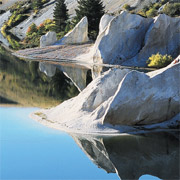Central Otago - Day Two
Clyde to St Bathans

In the morning after a hearty breakfast served in the dining room of Oliver’s charming homestead, we drive through Alexandra and on to historic Ophir. We reach this small settlement via a majestic suspension bridge built in 1880 prior to the Ophir gold rush of 1863. Back then the town boasted several stores as well as a school, police station, courthouse, post office, cottage hospital and doctor. We stop to admire these buildings, before driving on back roads through the Raggedy Range to Poolburn and onto Oturehua where we call into Hayes Engineering Works, established in 1895 by Ernest Hayes, an English engineer. Hayes invented several farm tools including the parallel wire strainer which is still used on modern farms today. We tour the plant which comprises several buildings and a windmill used to power his works, then head to Oturehua’s old store as Bob has a hankering for some gum.
“Wow, some store,” remarks Bob, as he heaves open a heavy green wooden door to a large warehouse which still has its original kauri counters, shelves and roll-a-door containers.
Gum purchased, we drive along Reefs Rd and walk to the Golden Progress Mine, where poised some 46 metres above the mine shaft is Otago’s only remaining example of a poppet head, a contraption used to hoist gold bearing ore to the surface.
Hunger forces us to leave the mine and continue on to Ranfurly, passing Wedderburn’s famous goods shed en route, retrieved from the Mt Ida Coal Mine by locals who were inspired by Grahame Sydney’s painting “July on the Maniototo” depicting the shed beside the Central Otago Rail Trail.
We admire Ranfurly’s wealth of art deco buildings, built in the 1930s after fire destroyed much of this historic gold mining town, while eating chicken and egg sandwiches at traditional kiwi tearooms on the main street.
The town became the railhead for the district in December 1898, providing a link between Dunedin and Central Otago’s gold field towns. Later the railway was extended to Alexandra, Clyde and Cromwell; today the railroad has been transformed into a 150 km long recreational Rail Trail suitable for hiking, horse riding and mountain biking.
The latter is a popular sport in the nearby village of Naseby, where Bob and I are greeted by a sign: “Welcome to Naseby - 2000 feet above worry level”.
“Isn’t that the whole of NZ?” questions Bob as we explore the historic cob and mudbrick buildings of this quaint gold mining town then pass the Naseby Forest where mountain biking enthusiasts congregate ready to tackle its trails.
In the winter an ice skating rink provides entertainment and the friendly lady manning the information centre tells us that curling, an old Scottish game akin to bowls on ice, is held here from June through to August.
It’s mid-afternoon so we backtrack on SH85 to Hills Creek then shortly after turn off for St Bathans, an old gold mining town nestled beside the Blue Lake Recreational Reserve. This tiny town has a permanent population of only five residents even though there’s many attractions including a stunning blue lake (dug by miners!), the famous Vulcan Hotel and several other notable buildings including the Bank of New South Wales Gold Office and Despatches, the old Post Office that now sells Victorian-style gifts. “It’s a real privilege to live here,” says Sharon Hinds when we call in.
We relax beside the beautiful sapphire waters of Blue Lake with its sculpted whitestone cliffs, then with some trepidation check into the Vulcan Hotel. It was built in 1882 from sun dried bricks, and rumour has it there is a resident ghost. Our hosts offer us the renovated Constable Cottage but Bob, eager to see if the ghost story is true, insists we stay in the hotel. As punishment I make him take the haunted room, while I ensconce myself in a ghost-free room next door! “Some say it’s an Australian gold miner, but most say it’s a girl with long brown hair,” says Jude Kavanagh, the publican’s wife. “I haven’t seen her but she’s not scary, just a tad naughty – she likes to hide things from time to time.”
After dinner and several glasses of ‘Dog’s Nose’, an old shearer’s drink, at the bar, Bob’s full of Dutch courage while I’m simply ready for bed. “Good luck!” I whisper at the door before I climb into my comfortable bed and fall immediately asleep.